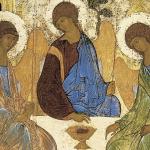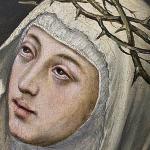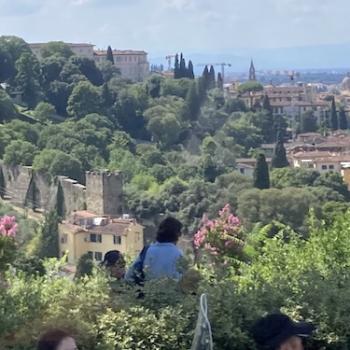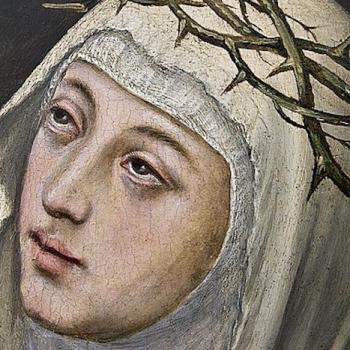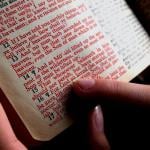
Pickstock’s Explosive World
“Truth,” Catherine Pickstock says, “is both a horizontal dance in time and a vertical dance in the skies.” This is one of the many lines of her recent book that generates a world of rich ideas.
Pickstock’s dense and generative theological philosophy has been my companion since graduate school. When she flew over from Cambridge to visit my University of Virginia, I had already read her first book. I was captivated that week by her lectures on Plato. In addition, she and my advisor, John Milbank, were working together on a book about Thomas Aquinas. I could hardly wait to get my hands on it.
There has always been for me something breathtaking about Pickstock’s thought. I go out following the many threads she is laying out for me, when I suddenly realize that they are all in fact fuses on sticks of dynamite. I can’t tell which one is going to light up first. Or if I have enough time to run for cover before the sky starts falling.
The Poetry of Truth
Her latest project, Aspects of Truth, sets out to demonstrate that “truth in things [is] an expression of things,” while “truth in the mind [is] a fulfillment of truth.” In other words, truth is not something that exists in the mind, nor something that exists “objectively” in reality, but is a linking of the objective truth of something with its subjective truthful interpretation.
This must be the case, Pickstock says. We are part of a cosmos created as an analogy for an infinite God. Part of: if we were not part of the world, we might say that the world alone images God by telling the truth. Then our job as mindful beings would be to seek coherence between our thinking/speaking and the truth the world tells.
But if we are part of it, then the work of telling the truth is more like that of a poet building meaning than it is like, say, an engineer building a bridge. The engineer makes the bridge “true” through more or less identical repetition. The poet makes meaning by adding rhythms and rhymes and combinations of words that have never yet existed. She speaks truth by adding something new. If the engineer does this too often, the bridge will not be one I want to cross. If the poet does not do it often enough, I will stop listening.
The Finite Way into Infinite Truth
In short, I can say something truthful, in the fullest sense of the word, only if I add the newness of my lived experience to it. Kierkegaard, one of Pickstock’s heroes, says something of this sort in his usual hyperbolic way. “To say a creed by rote is paganism, because Christianity requires inwardness.” He had nothing against creeds (or paganism, really), but he did have something against a faith that repeats ideas as “true” without transforming them through deep integration in one’s own subjectivity.
For Pickstock, we are part of a world that tells a finite story of an infinite God. This means that truth can never “show up” with any finality in the world. That would make truth as finite as us. My attempt to tell the truth begins in my acknowledgement of everything around me as gift. A gift, further, that is within the world because it originates beyond the world.
Truth as an Event
I don’t do right by a tree if I walk up to it and say “I can make you into something useful for me.” But I also don’t do right by the tree if I say “I should leave you alone so you can be yourself without me mucking things up.”
Instead, I come upon the tree as a gift that neither comes from nor ends with my presence. I listen deeply to what the tree has to tell me about itself, its environs, its botanical dreams. Then I respond as a poet would. I may build something with it, but if I do it will be “with the grain” of the tree’s existence. I may though, take a nap in its shade. Alternatively, I might bring my kids there for a picnic, or decide to climb it. It may be that the truth of the tree is performed in my climbing it in a way that it never yet has occurred. “Truth urges itself upon one, seeking to be expressed or performed.” Truth is like that: a lived event, more than a mathematical correspondence.
Jacob’s Ladder
One of the images that reoccurs in Pickstock’s book is that of Jacob’s ladder, from the Book of Genesis. Jacob is in “a certain place,” with his head resting on a rock, and finds that there are angels nearby passing from heaven to earth and from earth to heaven.
Notably, Jacob does wake up and say “heaven is truth, so this place is forgettable.” No, he anoints his stone pillow, thus rendering it a liturgical thing. He wants the next pilgrim who passes through to experience, non-identically, what he experienced. “Surely the Lord is in this place—and I did not know it!”
The image of the diagonal passage between realms is one that has inspired iconography, tricks with string, and heavy metal music. “We are climbing Jacob’s ladder…. Every step goes higher and higher.” Jacob did not dream an elevator to heaven. The descensions and ascensions are not vertical. Even the angels pass into heaven like Emily Dickinson’s truth tellers: at a slant.
Truth on a Diagonal
What Jacob witnesses, Pickstock says, is a kind of dance. Telling the truth about the world in front of us is a dance in time; when we take those steps, we are dancing also in the eternal truth that is God.
In short, we tell the truth of the infinite God above by paying attention to the finite world around us. (Surely God is in the place, if we could only see!). Likewise, we tell the truth (horizontally) of our finite world by celebrating the way we receive it (vertically), each moment, as a new gift from God. For Catherine Pickstock, the way of truth is a diagonal way.
Or actually, my account of the diagonal way has from the beginning been Pickstockian in character.

